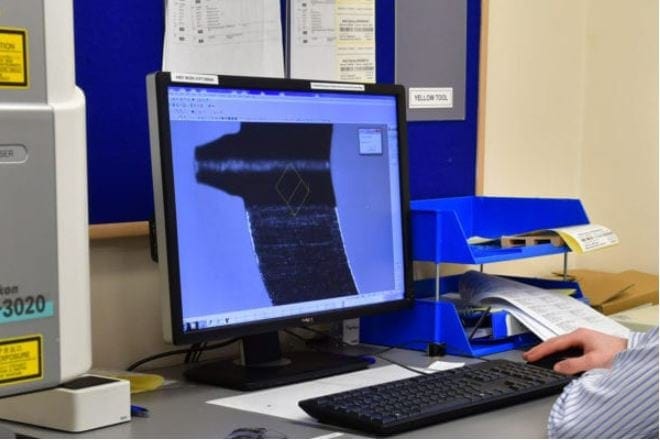What Is A Progression Tool?
Progression tooling uses automation to cut and bend a single sheet of metal.
This process works by feeding the metal into a press, before ‘progressing’ it through various stages of cutting and shaping. All of these stages use just one tool, until the final part is complete.
A progression tool is different from a traditional press tools because it works the material in more than one stage. As the process doesn’t require a different tool for each cut and bend, components can be made with tighter efficiency, lower cost and less waste.
What Are The Benefits Of Progression Tooling?
Progression tooling has a host of benefits that are very appealing to OEMs. They include:

- High volume production. Progression tooling is fast! A single, automated tool can create more parts, in a shorter period of time, than traditional fabrication or machining could allow. When a high volume of parts is required, progression tooling provides the lowest cycle times per finished piece.
- Less waste. Progression tooling can encompass punching, coining, bending and many other ways of modifying metal to produce a finished component. This means that the vast majority of metal on each sheet is put to use.
- Time efficiency. A single set-up will allow for multiple operations, which would have otherwise required numerous tools for different stages of fabrication. This not only saves production time, but time spent on tooling design and testing, too.
- Flexibility. Progression tooling can create multiple lines and shapes with one operation, allowing complex parts to be manufactured with ease.
- Repeatability. As progression tooling is well-suited to long runs, degradation of the die is very slow, meaning fewer failed parts over time and consistently high quality.
- Cost. Although the time and labour to produce a single progression tool is higher than for multiple presses, the speed and efficiency of the production line soon makes up for the initially outlay.
How Will Progression Tooling Benefit Medical Pressings?
Structural components are critical to a medical device’s function and longevity.
Medical device components are notoriously intricate, meaning that all metal parts must be stamped to stringent tolerances. Where accuracy is key, progression tooling is designed to meet that challenge.
Bringing a new medical product to market is also a notoriously slow process. Progressive tooling matches incredible precision with speed and turnaround time, reducing hold-ups while still creating quality parts. By empowering the process to action multiple geometries from a single die, the highest possible volume of part production can be delivered, producing a finished part with every cycle.
The speed and efficiency of this process allows ROI to be achieved quickly, even after the initial design and tooling costs. With the right engineering partner on board, this rapid manufacturing process will be complimented by expert guidance from the early stages of tooling design, allowing OEMs to focus on their most critical tasks and benefit from reliable outputs.
Why Work With Clamason For Your Progression Tooled Medical Device Pressings?

Clamason Industries provide an end-to-end solution, from initial design right through to storage and distribution.
All tooling is designed by in-house industry specialists, using state of the art CAD software, simulation technology and years of medical manufacturing experience. By harnessing this knowledge, Clamason can also help you to make essential decisions about the best method and material to implement, even for highly specialist devices.
Using only the world’s leading suppliers with relationships spanning decades, Clamason can guarantee reliability, with highly competitive prices and excellent turnaround times.
Why not contact our experts today
Did you know technical cleaning has usurped passivation in the production of medical device pressings? Find out why.

